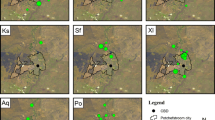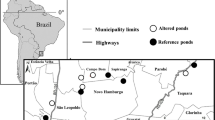Abstract
Fish introductions are considered one of the most widespread anthropogenic threats to aquatic ecosystems. Their negative impact on native amphibian communities has received increasing attention in recent years. We investigated the relationship between the introduced fish, emergent vegetation cover and native amphibians in man-made ponds generated by regulation and dam building along the Târnava Mare Valley (Romania) during the last 40 years. We inventoried amphibians and fish inhabiting 85 permanent ponds and estimated habitat complexity focusing on emergent vegetation cover. Four amphibian species were found to be negatively associated with the presence of predatory fish. Species richness of ponds without fish and ponds without predatory fish did not differ significantly, whereas ponds containing only predatory fish had significantly lower amphibian richness. A significant positive relationship was found between the emergent vegetation cover and pond occupancy of six amphibian species and amphibian species richness. As a management recommendation, we suggest the restriction of fish introductions to non predatory fish and the maintenance of high emergent vegetation cover in the ponds.


Similar content being viewed by others
References
Babbitt, K. J. & G. W. Tanner, 1997. Effects of cover and predator identity on predation of Hyla squirella tadpoles. Journal of Herpetology 33: 128–130.
Baker, J. M. R. & T. R. Halliday, 1999. Amphibian colonization of new ponds in an agricultural landscape. Herpetological Journal 9: 55–63.
Bănărescu, P. M., 1964. Pisces, Osteichtyes. Fauna R.P.R., XIII, Edit. Acadmiei, Bucureşti.
Berg, S., E. Jeppsen, M. Sondergaard & E. Mortensen, 1994. Environmental effects of introducing whitefish, Coregonus lavaretus (L.) in Lake Ring. Hydrobiologia 275/276: 71–79.
Bosch, J., P. A. Rincón, L. Boyero & I. Martinez-Solano, 2006. Effects of introduced salmonids on a montane population of Iberian frogs. Conservation Biology 20: 180–189.
Brönmark, C. & P. Edenhamn, 1994. Does the presence of fish affect the distribution of tree frogs (Hyla arborea)? Conservation Biology 8: 841–845.
Chapman, L. J., C. A. Chapman & M. Chandler, 1996. Wetland ecotones as refugia for endangered fishes. Biological Conservation 78: 263–270.
Crossland, M. R. & R. A. Alford, 1998. Evaluation of the toxicity of eggs, hatchlings and tadpoles of the introduced toad Bufo marinus (Anura: Bufonidae) to native Australian aquatic predators. Australian Journal of Ecology 23: 129–137.
de Nooij, R. J. W., W. C. E. P. Verberk, H. J. R. Lenders, R. S. E. W. Leuven & P. H. Nienhuis, 2006. The importance of hydrodynamics for protected and endangered biodiversity of lowland rivers. Hydrobiologia 565: 153–162.
Denöel, M., G. Dzukic, M. L. Kalezic, 2005. Effects of widespread fish introductions on paedomorphic newts in Europe. Conservation Biology 19: 162–170.
Ficetola, G. F. & F. De Bernardi, 2004. Amphibians in a human dominated landscape: the community structure is related to habitat features and isolation. Biological Conservation 119: 219–230.
Fielding, A. H. & J. F. Bell, 1997. A review of methods for the assessment of prediction errors in conservation presence/absence models. Environmental Conservation 24: 38–49.
Gillespie, G. & J.-M. Hero, 1999. Potential impacts of introduced fish and fish translocations on Australian amphibians. In Campbell, A. (ed.), Declines and Disappearances of Australian Frogs. Environment Australia, Canberra, 131–144.
Hartel, T., 2004. The long term trend and the distribution of amphibian populations in a semi-natural pond in the middle section of the Târnava-Mare Valley (Romania). Biota—Journal of Biology and Ecology 5: 25–36.
Hecnar, S. J. & R. T. M‘Closkey, 1997. The effects of predatory fish on amphibian species richness and distribution. Biological Conservation 79: 123–131.
Hoffman, R. L., G. L. Larson & B. Samora, 2004. Responses of Ambystoma gracile to the removal of introduced non native fish from a mountain lake. Journal of Herpetology 38: 578–585.
Holopainen, I. J., W. M. Tonn & C. A. Paszkowski, 1997. Tales of two fish: the dichotomous biology of crucian carp (Carassius carassius (L.)) in northern Europe. Ann. Zool. Fennici 34: 1–22.
Jesús, M. & F. M. Ángel, 2004. Comparison of statistical methods commonly used in predictive modeling. Journal of Vegetation Science 15: 285–292.
Joly, P. & C. Giacoma, 1992. Limitation of similarity and feeding habits in three syntopic species of newts (Triturus, Amphibia). Ecography 15: 401–411.
Joly, P., C. Miaud, A. Lehmann & O. Grolet, 2001. Habitat matrix effect on pond occupancy in newts. Conservation Biology 15: 239–248.
Kats, L. B. & R. P. Ferrer, 2003. Alien predators and amphibian declines: review of two decades of science and the transition to conservation. Diversity and Distributions 9: 99–110.
Kiesecker, J. M., A. R. Blaustein & C. L. Miller, 2001. Transfer of a pathogen from fish to amphibians. Conservation Biology 15: 1064–1070.
Knapp, R. A. & K. Matthews, 2000. Non-predatory fish introductions and the decline of the mountain yellow legged frog from within protected areas. Conservation Biology 14: 428–438.
Laan, R. & B. Verboom, 1990. Effects of pool size and isolation on amphibian communities. Biological Conservation 54: 251–262.
Larson, G. & R. L. Hoffman, 2002. Abundances of northwestern salamander larvae in montane lakes with and without fish, Mount Rainier National Park, Washington. Northwest Science 76: 35–40.
Laurilä, A., 2000. Behavioural responses to predator chemical cues and local variation in antipredator performance in Rana temporaria tadpoles. Oikos 88: 159–168.
Lodge, D. M., R. A. Stein, K. M. Brown, A. P. Covich, C. Brönmark, J. E. Garvey & S. P. Klosiewski, 1998. Predicting impact of freshwater exotic species on native biodiversity: challenges in spatial scaling. Australian Journal of Ecology 23: 53–67.
Long, J. S., 1997. Regression models for categorical and limited dependent variables. Advanced Quantitative Techniques in the Social Science Series 7. SAGE Publications.
Maezono, Y. & T. Miyashita, 2003. Community-level impacts induced by introduced largemouth bass and bluegill in farm ponds in Japan. Biological Conservation 109: 111–121.
Manatunge, I., T. Asaeda & T. Priyadarshana, 2000. The influence of structural complexity on fish–zooplancton interactions: a study using artificial submerged macrophytes. Environmental Biology of Fishes 58: 425–438.
Manteifel, Y. B. & A. N. Reshetnikov, 2002. Avoidance of noxious tadpole prey by fish and invertebrate predators: adaptivity of a chemical defence may depend on predator feeding habits. Archiv fur Hydrobiologie 153: 657–668.
Maret, T. J., J. D. Snyder & J. P. Collins, 2006. Altered drying regime controls distribution of endangered salamanders and introduced predators. Biological Conservation 127: 129–138.
Martinez-Solano, I., L. J. Barbadillo & M. Lapena, 2003. Effect of introduced fish on species richness and densities at a montane assemblage in the Sierra De Neila, Spain. Herpetological Journal 13: 167–173.
Matthews, K. R., K. L. Pope, H. K. Preisler & R. A. Knapp, 2001. Effects of nonnative trout on pacific treefrog (Hyla regilla) in the Sierra Nevada. Copeia 4: 1130–1137.
Meyer, A. H., B. R. Schmidt & K. Grossenbacher, 1998. Analysis of three amphibian populations with quarter-century long time-series. Proceedings of the Royal Society of London Britain 265: 523–528.
Nyström, P., L. Birkedal, C. Dahlberg & K. C. Brönmark, 2002. The declining spadefoot toad Pelobates fuscus: calling site choice and conservation. Ecography 25: 488–498.
Olden, J. D. & N. L. Poff, 2005. Long term trends of native and non-native faunas in the American Southwest. Animal Biodiversity and Conservation 28: 75–89.
Orizaola, G. & F. Brana, 2006. Effect of salmonid introduction and other environmental characteristics on amphibian distribution and abundance in mountain lakes of northern Spain. Animal Conservation 9: 171–178.
Pintar, M. & R. Spolwind, 1998. Mögliche koexistenz fon Fish- und Amphibianzönosen in Gewässern der Donauen westlich Wiens. Salamandra, Reinbach 34: 137–156.
Quinn, G. P. & M. J. Keough, 2002. Experimental Design and Data Analysis for Biologists. Cambridge University Press, Cambridge.
Real, R., J. Mario Vargas & A. Antúnez, 1993. Environmental influences on local amphibian diversity: the role of floods on river basins. Biodiversity and Conservation 2: 376–399.
Reshetnikov, A. N., 2003. The introduced fish, rotan (Perccottus glenii), depresses populations of aquatic animals (macroinvertebrates, amphibians and a fish). Hydrobiologia 510: 83–90.
Sas, I., S. D. Covaciu-Marcov, É. H. Kovács, N. R. Radu, A. Tóth & A. Popa, 2006. The populations of Rana arvalis Nills. 1842 from Ier Valley (The Western Plain, Romania): present and future. North-Western Journal of Zoology 2: 1–16.
Sass, G. G., C. M. Gille, J. T. Hinke & J. F. Kitchell, 2006. Whole-lake influences of littoral structural complexity and prey body morphology on fish predator–prey interactions. Ecology of Freshwater Fish 15: 301–308.
Schlinder, D. E., R. A. Knapp & P. R. Leavitt, 2001. Alteration of nutrient cycles and algal production resulting from fish introductions into mountain lakes. Ecosystems 4: 308–321.
Semlitsch, R. D. & H. U. Reyer, 1992. Modification of anti-predator behavior in tadpoles by environmental conditioning. Journal of Animal Ecology 61: 353–360.
Skei, J. K., D. L. Dolmen, L. Rønning & T. R. Ringsby, 2006. Habitat use during the aquatic phase of the newts Triturus vulgaris (L.) and T. cristatus (Laurenti) in central Norway: proposition for a conservation and monitoring area. Amphibia-Reptilia 27: 309–327.
Smith, G. R., J. E. Rettig, G. Mittelbach, J. L. Valiulis & R. R. Schaack, 1999. The effects of fish on assemblages of amphibians in ponds: a field experiment. Freshwater Biology 41: 829–837.
Staufer, H.-P. & R. D. Semlitsch, 1993. Effects of visual, chemical and tactile cues of fish on the behavioural responses of tadpoles. Animal Behavior 46: 355–364.
Tarr, T. L. & K. J. Babbitt, 2002. Effects of habitat complexity and predator identity on predation of Rana clamitans larvae. Amphibia-Reptilia 23: 12–20.
Teplitsky, C., S. Plenet & P. Joly, 2003. Tadpoles responses to risk of fish introduction. Oecologia 134: 270–277.
Tyler, T. J., W. J. Liss, L. M. Ganio, G. L. Larson, R. Hoffmann, E. Deimling & G. Lomnicky, 1998. Interaction between introduced trout and larval salamanders (Ambystoma macrodactylum) in high-elevation lakes. Conservation Biology 12: 94–105.
Van Buskirk, J., 2002. A comparative test of the adaptive plasticity hypothesis: relationship between habitat and phenotype in anuran larvae. The American Naturalist 160: 87–102.
Van Buskirk, J. & B. R. Schmidt, 2000. Predator induced phenotypic plasticity in larval newts: trade-offs, selection, and variation in nature. Ecology 81: 3009–3028.
Vredenburg, V. T., 2004. Reversing introduced species effects: experimental removal of introduced fish leads to rapid recovery of a declining frog. Proceedings of National Academy of Sciences 101: 7646–7650.
Wilhelm, S., 2000. Halak a természet háztartásában: édesvízi halaink biológiája. Kriterion Könyvkiadó, Bukarest.
Acknowledgements
We would like to thank Larissa Bailey, Geoffrey Smith, Anssi Laurilä, Günter Gollmann, Marcos Vaira, Mathieu Denoël and Nicholas Meade for the useful suggestions on an earlier version of the manuscript. Martha Cowell improved the English. This research was financially supported by a Declining Amphibian Populations Task Force grant, the Mihai Eminescu Trust and the Swedish Biodiversity Centre.
Author information
Authors and Affiliations
Corresponding author
Additional information
Handling editor: S. Declerck
Rights and permissions
About this article
Cite this article
Hartel, T., Nemes, S., Cogălniceanu, D. et al. The effect of fish and aquatic habitat complexity on amphibians. Hydrobiologia 583, 173–182 (2007). https://doi.org/10.1007/s10750-006-0490-8
Received:
Revised:
Accepted:
Published:
Issue Date:
DOI: https://doi.org/10.1007/s10750-006-0490-8




